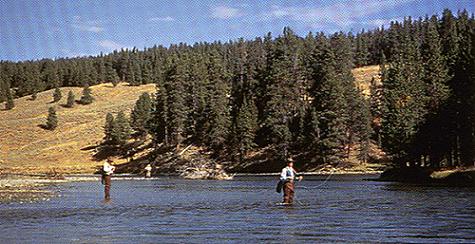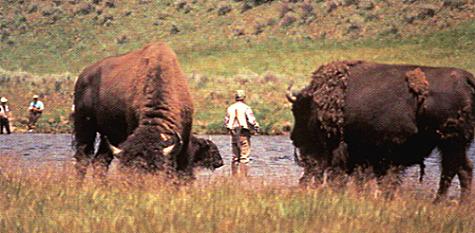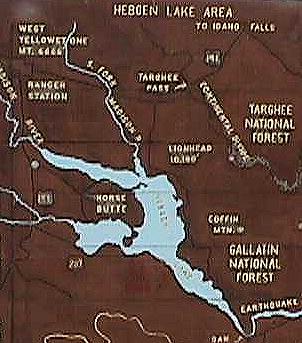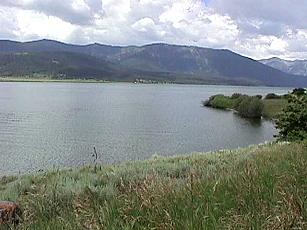The long hot summer days of August
bring low-water conditions and a change in tactics for the
fisherman. The upper Madison River, Firehole River, and
many of our small steams are low and clear. Using Grasshoppers,
Ants, Crickets and other terrestrial imitations will produce some
great mid-day fishing. Through the month of August and well
into September, using grasshopper imitations is challenging and
rewarding. At midday, trophy-size trout will take up feeding stations
near the banks of rivers and streams to inhale grasshoppers which
have fallen in the water. We have our own Jacklin's Hopper with
a light elk hair bullet head, sizes 8 to 10, which is easy to see and
works great. Remember, late summer is prime time for all small
streams. Here in Yellowstoneland, just about all rivers, streams and
even rivulets have a population of wild native trout. A short walk from
a roadside parking area will put you streamside and into a wild and
remote setting with great scenery, wild trout, and the big sky.

The upper and lower reaches of the Yellowstone
River in the Park are still in their prime with actively feeding fish and
good insect hatches. Caddis flies and Blue Wind Olives, sizes 16 and
18, work well. This time of year, I enjoy using a big Royal Wulff, size
10 or 12, just to fish the deep water. It works. Small nymphs are
also very effective, I like the Prince Nymph, Pheasant Tail, and the
Caddis Pupa. For the first time angler, this fishery is a must!

Starting in the high elevations of Yellowstone,
and flowing north into Montana along Highway 191, the Gallatin River is
a clear, cold mountain stream. Due to it's late runoff and cold temperature,
the Gallatin River is most productive from mid-July through late fall.
Fishing this water at midday with bright sun is most effective. Hopper
imitations and large dry flies will produce even when there are no
emerging insects. The Jacklin's Western Yellow Stone dry fly, size 8,
and my little Olive Stone, size 10, are both every effective on the
Gallatin at this time of year. The Gallatin River fulfills Webster's
definition of a freestone stream, for there are lots of large rocks and
boulders along the Gallatin's 40 miles of canyon water.

An interesting fishing opportunity develops
on Hebgen Lake during late July, August, and into mid-September.
During this period, a prolific hatch of tiny mayflies (the Trico) occurs
daily, if weather conditions are at all favorable. The sheer number of
flies on the water produce an amazing rise of sizeable trout. I have
caught wild browns and rainbows from 16" to 22" on small dry flies
and 6X tippets during this hatch. The primary method to fish for
these "Gulpers" is from a boat or float tube. Accurate casts of
30 to 60 feet are often required. A fly rod of nine feet or longer is
needed. I prefer a 5- or 6-weight forward floating line and a 12- to
14-foot leader for this fishing. Float tube rentals are available at
the shop. The best fly is our new "Paraspin" Trico, size 18 or 20.
Usually, the morning period with calm winds is the most
productive. When the hatch is on Hebgen Lake, it is readily
apparent why these fish are called "Gulpers." The sound of the
trout working dries on the surface is a distinctly audible "gulp."
It's quite a thrill to tighten on one of these rises and have your
reel sing to the power of a three-pound rainbow. These exciting
fish are quaranteed to put a smile on your face.

Stop at the shop if you'd like an experienced
guide, appropriate flies, or more information on this fine still
water fishing opportunity.~ Bob Jacklin
|





